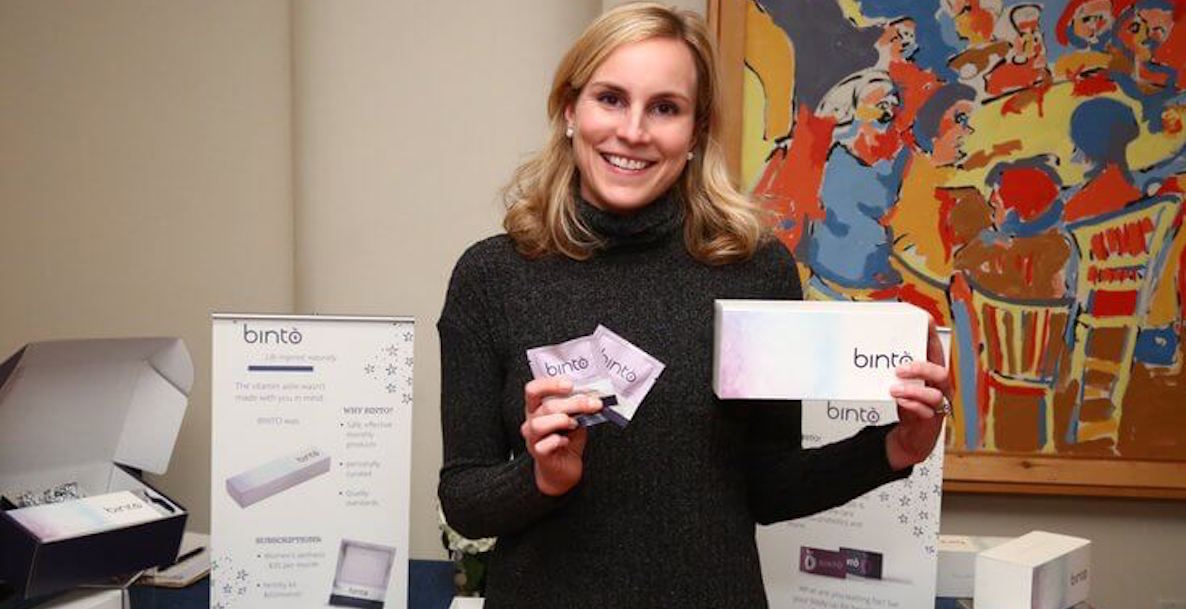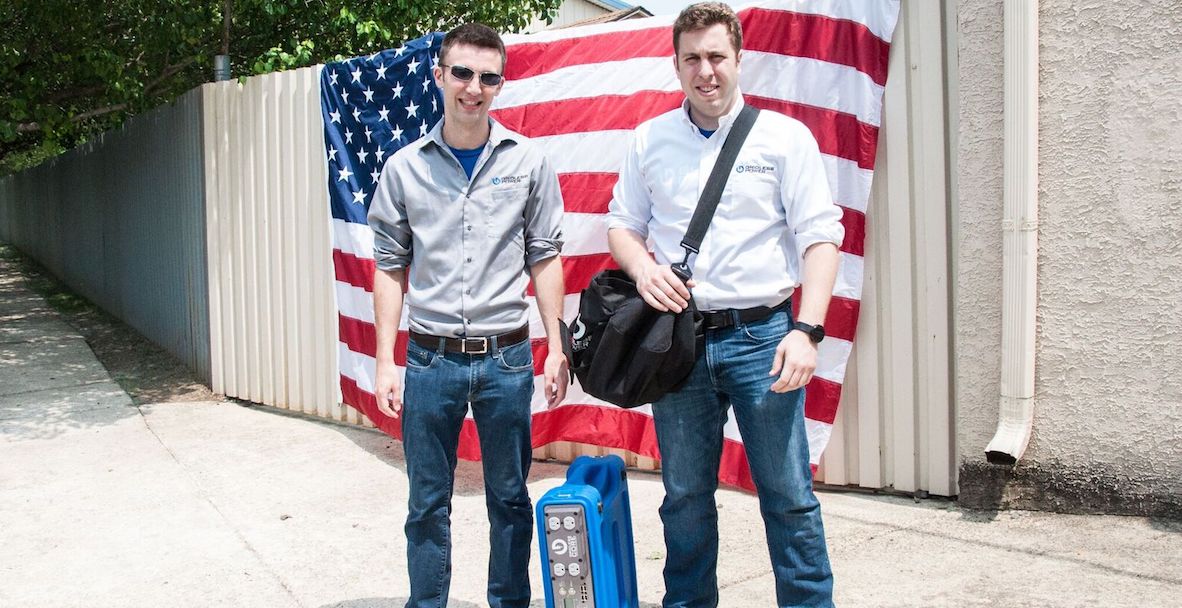Jason Halpern and Patrick Murphy, now both in their early 30s, first met—and became business partners, of a sort—in kindergarten.Halpern, at just five, had a knack for building pretty sweet toys out of blocks; and Murphy already had the savvy to trade them with other kids in their class for toys that the boys wanted more. They quickly became best friends, and by the end of high school in Collingswood, New Jersey the pair had decided they would go into real business together…of some sort, some day.
Little did they know that day would come so soon—and start at home, where the Halpern family was facing a quandary with their farm: They often needed to get power to the far reaches of their 5-acre farm. But existing electric generators were bulky, loud, and prone to fuel spills, all things not ideal on a farm that grows grapes for wine.
It was 2008, and the young men were juniors in college, studying what you might expect—Halpern engineering at Penn, and Murphy economics and business at New York University. Over the summer, they were vacationing together (as they often do) in Buxton, North Carolina, when Halpern mentioned he had an idea to solve the problem. Murphy, as always, jumped on it.
The Gridless 1250 is a solar- or outlet-charged portable battery that is silent, fumeless and, at just 50 pounds, the size of a carry-on suitcase. It can charge a cell phone 250 times or power a full-size refrigerator for a day before needing to be recharged.
Back home on the farm—and then on campus—Murphy got to work on the business end of the equation; and Halpern started building what would eventually become the Gridless 1250: a solar- or outlet-charged portable battery that is silent, fumeless and, at just 50 pounds, the size of a carry-on suitcase. Despite its lightweightness, it can charge a cell phone 250 times or power a full-size refrigerator for a day before needing to be recharged.
Soon after, they created a larger, more powerful version called the Gridless 7000, weighing in at 350 pounds, which is able to charge radios for two months or power stadium lighting for eight hours. The duo-turned-trio—long-time friend Andrew Leonard, who they met in the fourth grade, had joined the team—had found its long-awaited business plan.
Gridless is now being used across arenas and for vastly different purposes: supporting emergency response during hurricanes and wildfires through the Department of Defense; aiding construction in subway tunnels in San Francisco, where a generator would poison workers; and, most recently, ![]() powering concerts, outdoor events, and food trucks. The team has moved away from using the batteries for farming, but have the small vineyard to thank for their now growing business.
powering concerts, outdoor events, and food trucks. The team has moved away from using the batteries for farming, but have the small vineyard to thank for their now growing business.
The battery has also gone global and is supplying life-saving power in treacherous situations: It was used in Liberia during the Ebola crisis in 2014 and 2015 to power remote hospitals, and after the 2015 Nepal earthquakes to keep communication tools up and running.
“The humanitarian aid projects really help get us through the long nights and weekends working,” says Murphy. “Even something as small as powering a cell phone in a disaster area, so people can call their families and let them know they are okay, motivates us to get out there and grow the message.”
Though lower-grade versions of something like Gridless have been produced and purchased by consumers for years, Gridless is designed for large-scale use by professionals, like military and emergency responders.
Over four years of research and development, Murphy and Halpern graduated from sketching in dorm rooms to a windowless maker space in Collingswood, where they completed much of their prototyping. “We’ve since moved on to an office with actual windows, but we had fun with the early grind,” says Murphy. The company now has 15 employees.
But it faced two major setbacks on the journey from Collingswood farm to Nepalese earthquake relief. The first commercial product the company designed was called the PowerFlower, and it was a cheaper alternative to traditional solar panels at a time when they were expensive. But then, almost overnight, the cost of solar panels dropped rapidly.
“We were like, ‘Aw shit, this thing we’ve been working on for years has become obsolete,’” explains Halpern. “But we were small enough and nimble enough to make adjustments, and switched to more of a focus on the battery and the power side of it.”
Once the battery was designed, though, the trio faced another jarring surprise. They had produced the battery for the military, and had a tentative agreement from the U.S. Army to use it to power communication equipment on bases in Iraq and Afghanistan. But, at the hands of simply terrible timing, a 2012 sequester dried up any money for new military technologies. Halpern and Murphy now had a host of military grade power systems, and nothing to use them for.
“The humanitarian aid projects really help get us through the long nights and weekends working,” says Murphy. “Even something as small as powering a cell phone in a disaster area, so people can call their families and let them know they are okay, motivates us to get out there.”
Just as the friends were wondering how to salvage their business this time, Hurricane Sandy hit, ravaging nearby Jersey beach towns. There was a huge need for power—and Gridless had plenty of it. The partners knew some of the responders in Seaside Heights, so packed up their gear and headed east to the coastline to see how they could help. It was in these few days that they realized: natural disasters were where Gridless could do the most good.
“These guys have to go in and get a job done in adverse conditions, and the less they have to think about where they’re going to get their power, the better,” says Halpern.
This a-ha moment the led the group to “optimize and ruggedize the equipment for emergency aid.” ![]() The team started attending emergency management trade shows and working with regional emergency offices—including several who reached out to Gridless after their work on hurricane relief—then bigger organizations like Amtrak and, eventually, the Department of Defense again.
The team started attending emergency management trade shows and working with regional emergency offices—including several who reached out to Gridless after their work on hurricane relief—then bigger organizations like Amtrak and, eventually, the Department of Defense again.
Along the way, the team won money from several competitions and start-up funders, including the Wharton Venture Initiation Program and the Weiss Tech House Innovation Fund, for a total of around $40,000 in initial startup funds. They then won half a million from the Edison Innovation Green Growth Fund, which gave them the reputation they needed to secure funding from organizations like Investors’ Circle, which invests specifically in companies attempting to create a positive impact on the world through technology. All together, they have raised $2 million, which has gone toward the research and manufacturing of their Gridless generators.
Gridless generates most of its revenue through selling the equipment to buyers, like the Department of Defense, who then manage it on their own. They recently, though, started renting both models out through partner HercRentals; the smaller version is $99 a day and the larger $140 a day.
Though the Gridless team has created an alternative for generators, they don’t intend to—and really can’t—replace them. “Generators are really good at supplying a ton of power, like for AC for a huge tent. But there are a lot of areas where generators are not good,” explains Murphy. “This is just a swap ![]() out for areas where generators don’t make sense. We don’t want to replace everything, we want a more nuanced approach to power.”
out for areas where generators don’t make sense. We don’t want to replace everything, we want a more nuanced approach to power.”
While Gridless’ niche is life-or-death situations, the partners have an eye to growing their business in a more fun area of the market: outdoor events and concerts. Gridless was recently used as the exclusive source of power at the LGBT Center’s Garden Party during New York City Pride—a 2,000 person event—which allowed organizers to avoid extension cords, fumes and generator noise. Now, they have their aim set at Coachella. “When you’re in line for a food truck powered by a generator, you have to shout over it and smell the fumes,” says Murphy. “Folks are cognitive of it.”
Generators tend to burn diesel, and though the EPA has regulations governing how clean and efficient they must be, burning fuel always creates air pollution. This is particularly concerning in the case of outdoor events; sunlight combined with generators’ emissions can create toxic gas that affects breathing, particularly for those with asthma. Even more troubling, portable generators emit so much carbon monoxide that they killed 500 people who operated them indoors—or even outdoors near open windows—between 2005 and 2013.
Batteries meanwhile emit no pollution—whether at Coachella or a far-flung disaster zone. “We’re trying to get the word out into some of these new markets,” says Murphy. “You can use this for every outdoor event. You can really solve a problem with this.”
Photo Credits: Gridless






